Overview
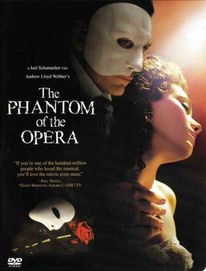
The film's DVD cover
The Phantom of the Opera was again translated into film in 2004. However, this edition was the highly anticipated musical edition. Yes, musical. Some of you may be saying... "Hey! They tried that once, didn't they!?" They did. However, that production became too costly, and was removed from production. For those who have no idea what's going on, we're speaking specifically of the Andrew Lloyd Webber musical edition. (As a side note, Webber has lost most of my respect for making a sequel which never should have existed, but that's my own problem. It's still a great musical.) Pictured to the left is the cover of the DVD, as it was sold upon initial release. The film is still fairly popular, and you can still easily pick it up in stores, particularly Target or any other major store. Anyway, moving on...
Throughout the movie, some parts are notably cut out. These were minor parts, but detracted from the novel-oriented air. One such instance is the removal of Notes II entirely, accompanied by the shortening and paraphrasing of many songs. However, some songs were actually extended, and, most notably, the history of Erik is more detailed within the film.
Throughout the movie, some parts are notably cut out. These were minor parts, but detracted from the novel-oriented air. One such instance is the removal of Notes II entirely, accompanied by the shortening and paraphrasing of many songs. However, some songs were actually extended, and, most notably, the history of Erik is more detailed within the film.
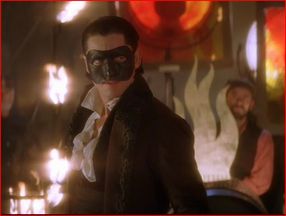
Gerard Butler portrays the Phantom
The film was directed by Joel Schumaucher. Because the film was made in 2004, Warner Brothers wanted to make the characters more youthful (in order to appeal to the modern audiences). According to the original story, experts estimate that Christine was around 17-29, while the Phantom was at least 10 years older. As such, they cast the following roles...
- Erik/The Phantom/Opera Ghost: Gerard Butler
- Christine Daaé: Emmy Rossum
- Raoul (Vicomte de Chagny): Patrick Wilson
- Madame Giry: Miranda Richardson
- Carlotta Giudicielli: Minnie Driver (Margaret Preece, singing)
- (Manager) Richard Firmin: Ciarán Hinds
- (Manager) Gilles André: Simon Callow
- Ubaldo Piangi: Victor McGuire
- Reyer: Murray Melvin
- Joseph Buquet: Kevin R. McNally
- Monsieur Lefevre: James Fleet
- Gustave (Christine's father)/ Daddy Daaé: Ramin Karimloo
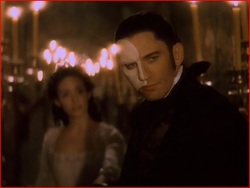
The beginning of the theme to the film
In order from the beginning to end, the songs are as follows. Additionally, the characters included in the song are listed, along with any notes which may be relevant to the song.
1. Prologue (Raoul [Older], Madame Giry [Older], Auctioners)
With the introduction of Phantom: The Las Vegas Spectacular!, the film's iconic raising of the chandelier while it restores the rest of the opera house has become live reality. The theater, modeled after the Paris Opera House, was specially designed to return to its original grandeur as it does in the film.
2. Overture/Hannibal (Carlotta, Christine, the managers)
3. Think of Me (Christine, the managers, Carlotta)
4. Angel of Music (Meg Giry, Christine)
5. Little Lotte/The Mirror (Christine, Phantom, Raoul)
More on this song forthcoming.
6. The Phantom of the Opera (Christine, Phantom)
The dramatic scenery is actually produced by using the set reconstruction used in the 1925 original film. This reconstruction was a precise model of the Paris Opera House underground, and has been used for more than just this particular edition.
7. The Music of the Night (Phantom)
8. I Remember/Stranger than You Dreamt It (Christine and Phantom)
This scene is placed much earlier in the film than in the book. The book retells Christine's stories of the ghost near the end, just before what would traditionally be considered the finale of the musical.
9. Magical Lasso (Joseph Buquet and the ballet girls)
Buquet was long dead by now within the book. Additionally, the 'magical lasso' is a reference to the Punjab lasso which Phantom traditionally uses. This is also why one must 'keep their hand and the level of their eyes'.
10. Notes/Primma Donna (Raoul, Carlotta, Meg Giry, Madame Giry, the managers, Phantom, Piangi)
11. Poor Fool, He Makes Me Laugh (Raoul, Carlotta, the managers, Piangi, Phantom)
12. Why Have You Brought Me Here/Raoul I've Been There (Raoul, Christine)
13. All I Ask of You (Reprise)/Chandalier Crash (Phantom, Christine, Piangi, Raoul, Carlotta, the managers)
Piangi is actually Carlotta's romantic interest. Hence why she is seen fleetingly sobbing over his dead body. Furthermore, it is also historically accurate. The chandelier did indeed fall, and it killed one (they were caught in the rope which held the chandelier aloft).
14. Masquerade/Why So Silent? (Phantom, Raoul, the managers, Christine)
The suit for this is actually similar in style to the vibrant red described in the book. However, the book depicted a man wearing a cloak which was inscribed with the words "do not touch me, I am the Masque of Red Death". Furthermore, the 1925 edition played upon this, though fitted Phantom with a more novel-accurate, full-face skull mask. Another point is that, within the musical, the line "to a new chandelier" is clearly audible during a small portion of the song.
15. Madame Giry's Tale (Raoul, Madame Giry, Phantom [Young], Madame Giry [Young])
This scene is, in the original novel, actually attributed to the Persian. However, in the film and the musical, the Persian and Madame Giry are intertwined. This also only fleetingly touches upon Phantom's architectural career and barely even details his love for the sadistic.
16. Journey to the Cemetery (Christine, Raoul)
17. Wishing You Were Somehow Here Again (Christine)
18. Wandering Child (Phantom, Christine, Raoul)
19. The Swordfight (Phantom, Raoul)
20. We Have All Been Blind (Raoul, the managers)
This song contains the remains of the completely massacred song, 'Twisted Every Way'. It replaced 'Notes II' completely.
21. Don Juan (Raoul, Christine, Carlotta)
22. Past the Point of No Return (Phantom, Raoul, Christine, Carlotta, the managers)
While this is indeed a part of the film, the song which is being sung in the book bears no relations to the song in the musical.
23. Down Once More/Track Down This Murderer (All)
24. Learn to be Lonely
This is available on the soundtrack, and is played during the credits. However, it is noted that this is the only scene in which we hear Minnie Driver (Carlotta's actor) singing. The other times were actually voice-overs by Preece.
1. Prologue (Raoul [Older], Madame Giry [Older], Auctioners)
With the introduction of Phantom: The Las Vegas Spectacular!, the film's iconic raising of the chandelier while it restores the rest of the opera house has become live reality. The theater, modeled after the Paris Opera House, was specially designed to return to its original grandeur as it does in the film.
2. Overture/Hannibal (Carlotta, Christine, the managers)
3. Think of Me (Christine, the managers, Carlotta)
4. Angel of Music (Meg Giry, Christine)
5. Little Lotte/The Mirror (Christine, Phantom, Raoul)
More on this song forthcoming.
6. The Phantom of the Opera (Christine, Phantom)
The dramatic scenery is actually produced by using the set reconstruction used in the 1925 original film. This reconstruction was a precise model of the Paris Opera House underground, and has been used for more than just this particular edition.
7. The Music of the Night (Phantom)
8. I Remember/Stranger than You Dreamt It (Christine and Phantom)
This scene is placed much earlier in the film than in the book. The book retells Christine's stories of the ghost near the end, just before what would traditionally be considered the finale of the musical.
9. Magical Lasso (Joseph Buquet and the ballet girls)
Buquet was long dead by now within the book. Additionally, the 'magical lasso' is a reference to the Punjab lasso which Phantom traditionally uses. This is also why one must 'keep their hand and the level of their eyes'.
10. Notes/Primma Donna (Raoul, Carlotta, Meg Giry, Madame Giry, the managers, Phantom, Piangi)
11. Poor Fool, He Makes Me Laugh (Raoul, Carlotta, the managers, Piangi, Phantom)
12. Why Have You Brought Me Here/Raoul I've Been There (Raoul, Christine)
13. All I Ask of You (Reprise)/Chandalier Crash (Phantom, Christine, Piangi, Raoul, Carlotta, the managers)
Piangi is actually Carlotta's romantic interest. Hence why she is seen fleetingly sobbing over his dead body. Furthermore, it is also historically accurate. The chandelier did indeed fall, and it killed one (they were caught in the rope which held the chandelier aloft).
14. Masquerade/Why So Silent? (Phantom, Raoul, the managers, Christine)
The suit for this is actually similar in style to the vibrant red described in the book. However, the book depicted a man wearing a cloak which was inscribed with the words "do not touch me, I am the Masque of Red Death". Furthermore, the 1925 edition played upon this, though fitted Phantom with a more novel-accurate, full-face skull mask. Another point is that, within the musical, the line "to a new chandelier" is clearly audible during a small portion of the song.
15. Madame Giry's Tale (Raoul, Madame Giry, Phantom [Young], Madame Giry [Young])
This scene is, in the original novel, actually attributed to the Persian. However, in the film and the musical, the Persian and Madame Giry are intertwined. This also only fleetingly touches upon Phantom's architectural career and barely even details his love for the sadistic.
16. Journey to the Cemetery (Christine, Raoul)
17. Wishing You Were Somehow Here Again (Christine)
18. Wandering Child (Phantom, Christine, Raoul)
19. The Swordfight (Phantom, Raoul)
20. We Have All Been Blind (Raoul, the managers)
This song contains the remains of the completely massacred song, 'Twisted Every Way'. It replaced 'Notes II' completely.
21. Don Juan (Raoul, Christine, Carlotta)
22. Past the Point of No Return (Phantom, Raoul, Christine, Carlotta, the managers)
While this is indeed a part of the film, the song which is being sung in the book bears no relations to the song in the musical.
23. Down Once More/Track Down This Murderer (All)
24. Learn to be Lonely
This is available on the soundtrack, and is played during the credits. However, it is noted that this is the only scene in which we hear Minnie Driver (Carlotta's actor) singing. The other times were actually voice-overs by Preece.
The film was slightly more romanticized than the musical. Furthermore, the lyrics were changed dramatically in some songs. For instance, within Think of Me, Raoul refers to Christine as being a formerly cocky and generally annoying girl. Due to the higher budget and the freedom alloted by having a film, there are also more special effects and some rearranged scores. Another interesting point is that one can easily tell the difference between the pipe organ used in the film and the electric organ used often in the stage productions. Some voice parts were also enhanced, including those of Carlotta and Christine. For more information on the songs specifically, you may refer to the songs section.
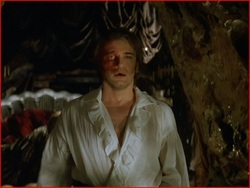
Gerard Butler's makeup
Another notable difference between the two works is the makeup and scarring on Phantom's face. The scarring is much less intense in the film, and is changed repeatedly. While in Past the Point of No Return, he is wearing a simplistic mask, it wouldn't have been able to cover up the makeup below. Another difference is that one can easily tell that the makeup is not applied throughout the film, and is applied only when needed. As such, this (in my opinion) detracted from the film. Another makeup mistake is the hairstyle. While during Past the Point of No Return it is clear that he also wore a wig of dark brown hair, it is in a different style than in the subsequent scenes. However, onto the makeup. As seen in the picture to the left, the left eye is inflamed, and the left side of the face looks like it's been burned. However, this is a minor deformity compared to some of the versions seen prior, including Lon Chaney's performance (the most accurate to date, at least according to those who have studied). At least it's more realistic than Herbert Lom's multicolored acid burns. Those were about as real as the old Aslan... and Google him, he's about as realistic as a kid in a Halloween costume.
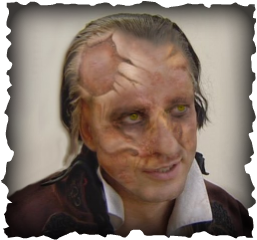
Michael Crawford, the original Broadway
Phantom in his makeup.
Phantom in his makeup.
Meanwhile, in the musical, the makeup is much more extreme. Supposedly, the makeup was dimmed in the musical due to Butler's refusal to wear such extreme facial makeup. However, the image to the right is far more accurate than the images seen in the film. Though... that thing that look like a cannonball hit him on the lead was never really described by Webber.
Moving on, the description in the book (the original by Gaston Leroux) explained that the Phantom had only a few wisps of hair, as seen in this (though not to the same extent in the musical). His eyes were so deeply set that one would "only see two deep black holes, as in a dead man's skull". This explanation is thus elaborated upon within the musical, as seen by his eyes (shadowed with black makeup). The eyes of Phantom were also said to be seen only at night, again a feature enhanced by Crawford's musical makeup. Furthermore, Phantom was often described as having the appearance of death, always dressed in fine clothing. All of these descriptions fit nicely.
As for the costume, the musical's costume is much more mysterious. The Phantom of the musical is depicted wearing a black fedora to hide his hair (no a wig). However, they got the half-face mask as in the movie.
Moving on, the description in the book (the original by Gaston Leroux) explained that the Phantom had only a few wisps of hair, as seen in this (though not to the same extent in the musical). His eyes were so deeply set that one would "only see two deep black holes, as in a dead man's skull". This explanation is thus elaborated upon within the musical, as seen by his eyes (shadowed with black makeup). The eyes of Phantom were also said to be seen only at night, again a feature enhanced by Crawford's musical makeup. Furthermore, Phantom was often described as having the appearance of death, always dressed in fine clothing. All of these descriptions fit nicely.
As for the costume, the musical's costume is much more mysterious. The Phantom of the musical is depicted wearing a black fedora to hide his hair (no a wig). However, they got the half-face mask as in the movie.
